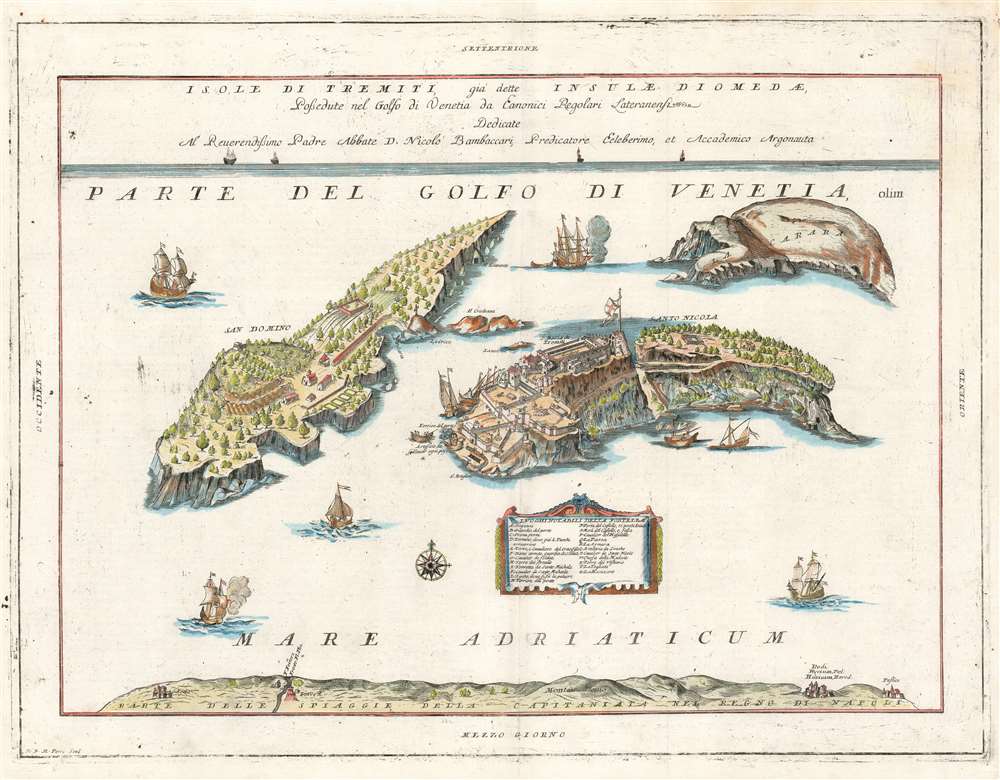This item has been sold, but you can get on the Waitlist to be notified if another example becomes available, or purchase a digital scan.
1697 Coronelli Map of the Islands of Tremiti
IsoleTremiti-coronelli-1697
Title
1697 (undated) 17.75 x 23.25 in (45.085 x 59.055 cm)
Description
Monastic Solitude
At the time this map was prepared, the islands had for almost three hundred years been in the possession of the Canons Regular of the Lateran, a Catholic order of priests and lay brethren who famously defended the islands from Ottoman attack in the 16th century.The islands have a somewhat longer history of involuntary settlement. In the first century CE, Augustus Caesar exiled his granddaughter Julia the Younger to one of these islands. In the 20th century, Mussolini interned prisoners there. And indeed, after he suppressed the Lateran Canons in 1783, Ferdinand IV of Naples would establish a penal colony in the Isole Tremiti.
In spite of the conditions which apparently make these islands suitable for monastic isolation and penal servitude, today they are part of Italy's National Parks, and enjoy what appears to be a thriving tourist trade, attracting divers in particular.
Census and Publication History
This map appeared in editions of Coronelli’s Corso Geografico Universale in 1692. It was also included in his Atlante Veneto in 1697, and the presence of verso text indicates that this example is from the latter work. This edition of the map is catalogued separately only by the Biblioteca Nacional de Espana. The Atlante Veneto is well represented in institutional collections.Cartographer
Vincenzo Maria Coronelli (August 16, 1650 - December 9, 1718) was an important 17th-century cartographer and globe maker based in Venice. Coronelli was born the fifth child of a Venetian tailor. Unlikely to inherit his father's business, he instead apprenticed in Ravenna to a woodcut artist. Around 1663, Coronelli joined the Franciscan Order and, in 1671, entered the Venetian convent of Saint Maria Gloriosa dei Frari. Coronelli excelled in the fields of cosmography, mathematics, and geography. Although his works include the phenomenal Atlante Veneto and Corso Geografico, Coronelli is best known for his globes. In 1678, Coronelli was commissioned to make his first major globes by Ranuccio II Farnese, Duke of Parma. Each superbly engraved globe was five feet in diameter. Louis IV of France, having heard of the magnificent Parma globes, invited Coronelli to Paris, where from 1681-83 he constructed an even more impressive pair of globes measuring over 12 feet in diameter and weighing 2 tons each. The globes earned him the patronage of Louis XIV and privileged access to French cartographic information from Jesuit sources in the New World, particularly Louisiana. Coronelli returned to Venice and continued to publish globes, maps, and atlases, which were admired all over Europe for their beauty, accuracy, and detail. He had a particular fascination for the Great Lakes region, and his early maps of this area were unsurpassed in accuracy for nearly 100 years after their initial publication. He is also well known for his groundbreaking publication of the first accurate map depicting the sources of the Blue Nile. At the height of his career, Coronelli founded the world's first geographical society, the Accademia Cosmografica degli Argonauti, and was awarded the official title Cosmographer of the Republic of Venice. In 1699, in recognition of his extraordinary accomplishment and scholarship, Coronelli was also appointed Father General of the Franciscan Order. The great cartographer and globe maker died in Venice at the age of 68. His extraordinary globes can be seen today at the Bibliothèque Nationale François Mitterrand in Paris, Biblioteca Marciana in Venice, the National Library of Austria, the Globe Museum in Vienna, the Library of Stift Melk, the Special Collections Library of Texas Tech University, as well as lesser works in Trier, Prague, London, and Washington D.C. Coronelli's work is notable for its distinctive style, which is characterized by the high-quality white paper, dark intense impressions, detailed renderings of topographical features in profile, and numerous cartographic innovations. More by this mapmaker...

